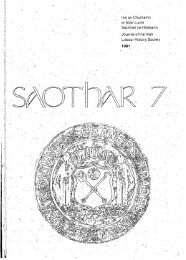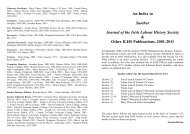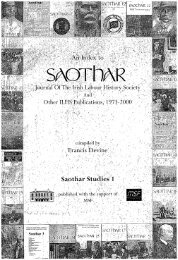36 SAOTHAR 13Bennett as honorary secretary; the offices were at Denmark House, 21 Great Denmark Street, Dublin.Bennett's most clearly articulated ideas on the future of the union and the unionisation of womenworkers coincided with her editorship of the Irish Citizen in 1920, although a period during HannaSheehy-Skeffmgton 's absence in America in 1916-1917 was a crucial prelude. In these early editorials,the Irish Citizen departed from its traditional emphasis on suffrage issues to take up the gauntlet forthe women worker. There were repeated calls to 'organise, organise'. One issue announced theemergence of a hitherto unheard of class - the woman worker - who having long been 'down by fearand miserable conditions ... has aroused at last to a realisation that ... her fate is in her own hands andthat ... she has in trade unionism a force to control it. '39 The March 1917 issue expressed horror at thelow pay for women and said that as long as women held themselves cheap, 'they will be recompensedaccordingly'. Bennett deliberately organised the IWWU on a single-sex basis.'It is futile to deny a latent antagonism between the sexes in the world of industry. There is a dispositionamongst men workers not only to keep women in inferior and subordinate positions, but even to drive themout of industry altogether ... Men have not the same aspirations for women as women have for themselves,and in an organisation much time and trouble would have to be wasted in securing the co-operation of themen in a demand for reforms of which the women may feel urgent need. For it must always be borne inmind that in mixed trade unions the men are practically always the dominant element. '40Responding to counter-arguments from Cissie Cahalan of the Linen Drapers' Assistants' Association,who favoured mixed trade unions,41 Bennett claimed that until the sex problem in industry wassolved, industrial unionism was a non-starter. The purpose of the IWWU must therefore be to act as a'force in raising the status of women in industry and in influencing public opinion on industrial and socialproblems where they particularly affect women ... For the moment at any rate, I think the women in mosttrades would do better to organise independently of men within a women's federation, but it would havethe closest possible co-operation with the men's unions in the same trades on matters of common interestto both.'Moreover, Bennett recommended that women in other unions should join the IWWU and 'remain init until they have secured equal pay with the men in their respective firms' .42 The debate continued fordecades, with the IWWU arguing consistently that women, because of the' definite lines of demarcation[that] separate their work from that of men', required a separate trade union. 43 Helena Molony, as amember of the ITUC Commission of Enquiry into Trade Union Reorganisation in 1936, acknowledgedthat while 'the policy of organising women on sex lines' might be 'theoretically wrong', it wasnevertheless necessary under the circumstances. 44The most interesting and curious aspect of this entire debate was the constant reassurance thatunionised women workers would never seek to 'encroach on the men's sphere' .45 Bennett had madethis point very clear in her initial article on the subject in the Irish Citizen of November 1919:'In a society where the financial burden of keeping the home lies upon the male wage-earner, workingunder a system so heedless of human needs as the industrial system of today, it would be madness of womenworkers to attempt to disturb fundamentally the present distribution of work.'46This was a theme to which Bennett returned often; her address as lTUC President in 1932 went as faras to question the usefulness of women working at all.'N aturally, I have no desire to put a spoke in the wheel of women's employment. But this modem tendencyto draw women into industry in increasing numbers is of no real advantage to them. It has not raised theirstatus as workers nor their wage standard. It is a menace to family life, and in so far as it has blocked theemployment of men it has intensified poverty amongst the working clasS.'47
-.- '.LOUlE BENNETT 37While there is little doubt that in this respect BenneU mirrored conventional opinion, the views weremoderating in their impact. 48 .It was Bennett's traditional views on women working that dominated the IWWU contributions tothe debate on equal pay for equal work. Her persistent claims that there was a fundamentaiprincipleof equal rights and opportunities for all citizens rang hollow against her more negative assertions. 49This was particularly the case in the debates about the tailoring trade in the 1930s and 1940s. The majorunion involved was the National Union of Tailors and Garment Workers (NUTGW), composedprimarily of men, because men dominated the key operations like cutting, fitting, trimming, shaping,basting, alterations, pressing by hand or by machine, passing or viewing, packing and dispatching. Thecheapness of female labour threatened what had traditioria:ily beeha male preserve. In 1936 and againin 1941 the union, with the backing of the ITUC, approached the Minister for Industry and Commerce,Sean Lemass, with the view to having him introduce regulations, under section 16 of the 1936Conditions of Employment Act, restricting the access of women to the above-named operations. 50 TheMinister refused and was denounced loudly by the NUTGW; Mrs. Purtell, from that union, agreed withher male colleagues that women, particularly married women, should not be employed over men,especially when so many men were unemployedY Interestingly, only Bennett dissented. 52 Yet, if wetake Bennett's comments in 1942 in the context of her expressed scepticism of the value of women'swork, it seems clear that equal pay for equal work was a means of eradicating the 'advantage' thatwomen had over men, and thereby forcing them out of the labour market. This does notignore the.fundamentally progressive notion, but it does suggest a more traditional perspective from whichBennett and the IWWU were working. Indeed, both the concept of equal pay and that of noninterferencein male jobs reveals a deep rooted conservatism; likewise, the 1936-37IWWU AnnualReport opposed the shift system because it added 'seriously to the difficulties of the housekeeper andtends to disrupt home life and family relations' .53 Thus, working women were an aberration of modemsociety. While the union would represent their interests - and those areas which it defined as appropriatetargets it pursued relentlessly and progressively - it would not, nor did it ever, challenge the traditionaldual role of women as workers and as mothers' or the sexual division of labour.The IWWU, as Bennett saw it, was not an instrument of class power. Rather she suggested that theIWWU would be part of a larger women workers' federation which would draw together womenworking in all fields, both individually and industrially, under three general headings:'1. Women workers in industries which are quite clearly women's industries, or where the men'sorganisations do not admit them, or where their interests or desires are likely to be bestcserved by apurely women's organisation - to be organised as in the IWWU;2. Groups of women a1rea~y organised in craft or industrial unions with men, loosely affiliated with thewomen's federation, in order to work for better general conditions for work - women as a class - to paysmall affiliation fee; - .3. Individual women workers, professional, commercial or industrial ... they should have no control over·the actual trade union business of the Federation nor over its constitution. '54Initially, there were two key sections of the union/federation - nurses (who by 1920 had been formedinto the Irish Nurses' Union under the aegis of the IWWU) and domestic workers. Thedomestics hadpreviously been organised by Helena Molony who had been Secretary of the Domestic Workers'Union; the Irish Citizen of August 1919 noted that its membership stood at about 15,000. 55 Bennettthen concentrated on the printing trade and the laundries. There is little additional evidence of anyfurther progress towards fulfilling the schema that Bennett had mapped out for the IWWU as outlinedabove. It does illustrate, however, her belief that women were a body in society which shared certaincommon interests and abilities, and that one of these was their 'humanising' quality wiihout whichsociety was all the poorer. 56 While at other times she did articulate the sentiments abOut the 'labourclass' or the 'working people', she shared little sympathy with socialist or labourist notions of Class or
- Page 1 and 2: JOURNAL OF THE IRISH LABOUR HISTORY
- Page 3 and 4: ContentsPageEditorial: Labour Histo
- Page 5 and 6: EDITORIAL 3freedom to participate i
- Page 7 and 8: CorrespondenceThe Irish Labour Part
- Page 9 and 10: ; ~ ; ,The Decline and Fall of Donn
- Page 11 and 12: THE DECLINE AND FALL OF DONNYBROOK
- Page 13 and 14: THE DECLINE AND FALL OF DONNYBROOK
- Page 15 and 16: ·' THE DECLINE AND FALL OF DONNYBR
- Page 17 and 18: THE DECLINE AND FALL OF DONNYBROOK
- Page 19 and 20: THE DECLINE AND FALL OF DONNYBROOK
- Page 21 and 22: THE DECLINE AND FALL OF DONNYBROOK
- Page 23 and 24: THE DECLINE AND FALL OF DONNYBROOK
- Page 25 and 26: ,'-,;-''''.A PASSAGE TO BRITAIN 23C
- Page 27 and 28: A PASSAGE TO BRITAIN 25only in the
- Page 29 and 30: A PASSAGE TO BRITAIN 27clothing._De
- Page 31 and 32: A PASSAGE TO BRITAIN 29established
- Page 33 and 34: ;:-.",.- .. .", ...... '.:. '
- Page 35 and 36: LOUIE BENNETI 33feminist movement w
- Page 37: :... ~: ."
- Page 41 and 42: LOUIE ~ENNEIT 39Xl's encyclical Qua
- Page 43 and 44: LOUIE BENNEIT 41Bennett's own relat
- Page 45 and 46: LODIE BENNETT 43109; IWWU resolutio
- Page 47 and 48: Essays in ReviewCosherers, Wanderer
- Page 49 and 50: ••• .".'. >. '~"ESSA YS IN RE
- Page 51 and 52: ESSAYS IN REVIEW 49ConnolIy:Myth an
- Page 53 and 54: ESSAYS IN ~EVIEW 51tion' in the Int
- Page 55 and 56: ESSAYS IN REVIEW53International:'I
- Page 57 and 58: REVIEWScontroversy is real history.
- Page 59 and 60: REVIEWSJoe Monks was among the earl
- Page 61 and 62: REVIEWSnolly-Column Song','Proudly
- Page 63 and 64: REVIEWSresulting from the arrival o
- Page 65 and 66: REVIEWS,63the book by means of an a
- Page 67 and 68: REVIEWSlogue, it is hardly surprisi
- Page 69 and 70: The Team For All Workers ...CULIAIB
- Page 71 and 72: ESSAYS 69mission and moral refonn.l
- Page 73 and 74: .. ...... ~.~ -~ .'- '.ESSAYS. 71fr
- Page 75 and 76: ESSAYS 73claimed authority but whic
- Page 77 and 78: ESSAYS 75provided the basis for soc
- Page 79 and 80: ESSAYS 779. For comparisons see E.T
- Page 81 and 82: ESSAYS 7952. Annals of Christ Churc
- Page 83 and 84: ESSAYS' 81Fianna Fail and the Worki
- Page 85 and 86: ESSAYS 83Eireann in 1925 visibly di
- Page 87 and 88: ESSAYS 85recognition of the impract
- Page 89 and 90:
ESSAYS 871970, it created the condi
- Page 91 and 92:
ESSAYS89The Irish Immigrants' Contr
- Page 93 and 94:
ESSAYS" 91Although anti -Catholic p
- Page 95 and 96:
ESSAYS 93McCowie played a key role
- Page 97 and 98:
:. -,,'.' ',. .~.,:.ESSAYS 95Althou
- Page 99 and 100:
ESSAYS 97young girl of their own ba
- Page 101 and 102:
SourcesIrish Labour History Society
- Page 103 and 104:
SOURCES 101INovember, 1971 to no. 1
- Page 105 and 106:
SOURCES 103would claim credit for t
- Page 107 and 108:
SOURCES105Sources for Irish Labour
- Page 109 and 110:
SOURCES 107NorthWest Archives and L
- Page 111 and 112:
SOURCES 109In 1966 the Finnish gove
- Page 113 and 114:
TURNINGANEWLEAFThe CPSSUis the larg
- Page 115 and 116:
REMINISCENCE 113us due to my politi
- Page 117 and 118:
REMINISCENCE 115when Jim was presen
- Page 119 and 120:
REMINISCENCE 117of Dail Eireann. 17
- Page 121 and 122:
REMINISCENCE 119NotesThe above arti
- Page 123 and 124:
DOCUMENT STUDY 121James Connolly in
- Page 125 and 126:
DOCUMENT STUDY123SOCIAL DEMOCRATIC
- Page 127 and 128:
DOCUMENT STUDY 125proletariat of th
- Page 129 and 130:
DOCUMENT STUDY 127the support of Je
- Page 131 and 132:
DOCUMENT STUDY 12926. The Workers'
- Page 133 and 134:
131BibliographyA Bibliography of Ir
- Page 135 and 136:
BIBLIOGRAPHY 133Compton, P.A. Demog
- Page 137 and 138:
BIBLIOGRAPHY 135Levine, I. and Madd
- Page 139 and 140:
BIBLIOGRAPHY 137Turner, M. 'Towards
- Page 141 and 142:
BIBLIOGRAPHY 1394. Land and Agricul
- Page 143 and 144:
BIBLIOGRAPHY 141Clogher Record12 (2
- Page 145 and 146:
BIBLIOGRAPHY 143Political Research
- Page 147 and 148:
BIBLIOGRAPHY 145Pres, 1987.O'Brien,
- Page 149 and 150:
147Notes on Contributorsf onathanBe
- Page 151 and 152:
1901: Ireland's first general union
- Page 153 and 154:
ELECTRICAL TRADES UNION .Establishe





